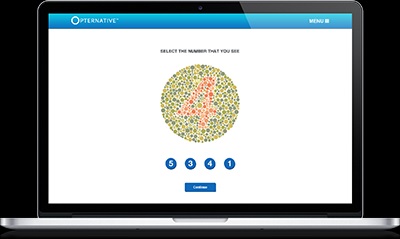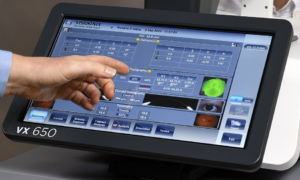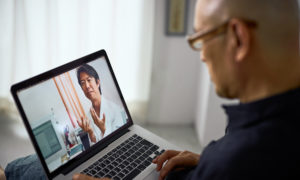By Steve Vargo, OD, MBA
SYNOPSIS
Imagine a patient getting an exam or having a consult online. Telemedicine is a reality—and it can extend your reach in providing eyecare to more patients.
ACTION POINTS
UNDERSTAND TELEMEDICINE. Includes: Online refractions, video consultants and eConsults, which store and forward captured off-site data to an eyecare professional for review and interpretation.
MEET HIPAA REQUIREMENTS. Use a HIPAA-compliant third-party platform to facilitate telemedicine. These range in cost from free to around $300 per month.
ENCOURAGE IN-PERSON EXAMS. Offer simple visual assessment on your site that alerts patients it may be time for a new pair of glasses.
Photo: from www.opternative.com
Telemedicine is the remote diagnosis and treatment of patients via electronic communications from one site to another. Telemedicine includes a variety of applications and services using two-way video, e-mail, smartphones, wireless tools and other forms of telecommunications technology–and it has a potentially significant place in optometry.
Over the last year, “telemedicine” has been in the news, most recently with the launch of Opternative, a site that is seeking funding and FDA approval to offer online refractions. Other examples of telemedicine include video consultation, eConsults and mobile apps.
It’s likely that soon macular degeneration, glaucoma and other eye diseases, will be screened through telemedicine inthe next five to 10 years, or earlier. With an aging population, and a limited capacity to provide traditional eyecare, this is inevitable. As the burden of disease and risk outpaces the ability to care for these patients face-to-face, we will likely see more of it relegated to telemedicine and remote care. When a HIPAA-compliant system is used to facilitate telemedicine, this new modality can be used as a tool that provides better access and convenience for patients.I think telemedicine will benefit health care, mostly through improved efficiencies, convenience and lower health care costs. Many “traditional” doctors may be slow to embrace it, but I think it will become more mainstream and accepted by both doctors and patients alike in the next five to 10 years.
eConsults
Mobile Apps
Video Consultations
Professional-to-Professional
Patient-to-Professional
Professional-to-Patient
Images are captured, stored and forwarded off-site to an eyecare professional for review and interpretation.
Capable of performing basic refractions and cataract screenings via HIPAA-secure apps, pictures of the patient’s eye are taken and forwarded to an eyecare professional.
Using a platform similar to SKYPE (but HIPAA-compliant), the eyecare professional consults with patients to determine whether they need to come in for a visit or have a prescription called in.
Easy Applications to Optometric Practice
I do not use telemedicine in my practice yet, but I am thinking of ways of using it in the future. The most intriguing application to me is video consultation, in which doctor and patient interact via video online, and eConsults, in which a photo of the eye is sent electronically by e-mail or text via a secure network. I think it would be very convenient for patients and doctor to do simple visits such as routine follow-ups via video. This is especially convenient for patients who travel long distances to see you, are away at college or living out-of-town temporarily for work. For example, using eConsults, a nurse practitioner could forward an image of eye trauma or pathology for review and interpretation by an eye doctor.
A few of the concerns at this time hindering wide use of video consultation and eConsults are privacy and billing. Skyping your patients can be done, but is it reimbursable and HIPAA-compliant? The optometric profession is still looking for the answers to those questions. Some of the newer technologies addresses this, but we haven’t invested in that yet. However, I think this will eventually become integrated into much of the technology we use now, such as electronic records.
Here are the major forms of telemedicine and what you can do to ensure telemedicine is used to help your patients.
eConsults
eConsults involve storing and forwarding images captured off-site to an eyecare professional for review and interpretation. An example in eyecare would be retinal screenings enabled by telemedicine technology. Yale Eye Center participates in a program where trained medical assistants take digital images and send them electronically for evaluation. The doctors are paid a flat fee to provide this service. Follow-up and in-person care is provided as needed. The program has increased access to screenings, lowered costs and improved patient satisfaction. These programs may be most beneficial in underserved communities, where access to regular care may be limited by the lack of eye doctors, according to the study, “Telemedicine-Based Eye Examinations Enhance Access, Reduce Costs, and Increase Satisfaction for Low-Income and Minority Patients with Diabetes | AHRQ Innovations Exchange“
Video Consultations: A Growing Trend
Video consultations are anticipated to greatly impact the traditional health care model. According to Parks Associates, the number of households using video consultations with physicians will grow from 900,000 in 2013 to 22.6 million in 2018. This report also estimated that video consultation revenues will grow from under $100 million in 2013 to $13.7 billion in 2018. Kaiser Permante recently launched a program called HouseCalls that provides 20-minute telemedicine appointments to about 30 patients a day. According to a survey by Mercer, 10 percent of large employers with employer-sponsored health plans are already using telemedicine. While many people still prefer face-to-face interaction with their doctors, the numbers are showing a trend toward greater acceptance of online communication.
Mobile Apps
Recently, Lux Research analysts explored the potential for telemedicine across several specialties. According to their researchers, “ophthalmology will quickly offer consumers multiple devices for self-diagnosis and monitoring of conditions such as cataracts or glaucoma.”
There currently exists apps that are capable of performing basic refractions and screening for cataracts, although these are mostly used in remote areas, such as underdeveloped regions. As noted, using a phone to take pictures of eye conditions and forward the image to an eyecare professional (via HIPAA-secure apps) for evaluation has a lot of potential in eyecare.
Apple reportedly is entering the telemedicine arena with a “health tracking app” for the iPhone that will monitor a variety of vital signs and interface with the medical team of the user—even reporting irregular heartbeats an low blood sugar levels. Apps for other types of smartphones are expected to follow.
What Does Telemedicine Mean to ODs?
Video consultations and eConsults have the potential to improve efficiency, lower costs and increase patient load. Obviously, telemedicine also has an ominous side. Refracting kiosks and online eye exams present a threat to many ODs. Not just from a business perspective, but a declining public perception of the value of our services. ODs must get out in front of this by educating patients (and public at large) of the value of a comprehensive eye exam, which includes a thorough assessment of ocular health. Many eye diseases could go missed or undiagnosed by foregoing a thorough exam by a trained professional. ODs should also have a strong presence in the governing bodies that will shape the laws pertaining to these issues.
Meet HIPAA Requirements
Some ODs use Skype to consult with patients, but doctors must consider privacy issues. I think eventually what we will see is HIPAA-compliant communication systems that allow video consultations, similar to HIPAA-compliant e-mail and text messaging offered through some of the popular patient communication systems. Click HERE for direction from the Telehealth Resource Centers regarding preserving privacy in telemedicine.
Respect your patients’ privacy by abiding by all HIPAA regulations. Choosea HIPAA-compliant third-party platform as your telemedicine medium, and make sure patients are comfortable with this format. Some of these systems integrate into your own web site, with prices ranging from free to around $300 per month. Click HERE for a Google listing of HIPAA-compliant third-party platforms that can be used for online consultations.
Use Telemedicine Yourself for Non-Critical Evaluations
Not every eye health or vision need will lend itself to telemedicine. Many patients need to be seen and evaluated in-person. However, for situations where a face-to-face encounter is not critical (i.e. routine follow-up), it’s likely that many patients would appreciate the convenience and time-saving component of telemedicine. For example, when medically appropriate, patients could schedule a follow-up appointment via video over their lunch hour at work. This avoids the need to drive to the office and wait to be seen.
Another example would be vision therapy. After the initial office consultation, most vision therapy programs involve exercises performed at home, with scheduled in-office progress follow-ups. Video follow-ups might be a great way to see more vision therapy patients who have to drive long distances for care, or find it difficult to schedule around school or work schedules.
As technology in this area advances, I would market the “convenience” aspects of telemedicine. If access to your patients was improved without compromising the level of care, this could be a valuable practice builder.
Encourage Patients to Come In Via Telemedicine
Telemedicine can even be a way of alerting patients and potential patients that an in-person visit to their eye doctor is necessary. TheEyeXam app allows patients to take a self-guided vision screening and then schedule an appointment with a participating eyecare provider. It’s possible that many, if not most, ODs may eventually offer similar technology through their web site or social media sites to alert patients that something is amiss and they should make an appointment to see their doctor–in person.
Related ROB Articles
Five Great Apps to Help You Talk to Patients About Eye Health
Make Your Web Site Mobile-Friendly
Make it Simple to Make an Appointment Online
 Steve Vargo, OD, MBA, is president of New Media OD in St. John, Ind., a company that specializes in online marketing for doctors. He is also a consultant for the EyeXam mobile application. In addition, Dr. Vargo is an associate with Eagle Eye Optique, a private practice in Crown Point, Ind. To contact him: NewMediaOD@gmail.com
Steve Vargo, OD, MBA, is president of New Media OD in St. John, Ind., a company that specializes in online marketing for doctors. He is also a consultant for the EyeXam mobile application. In addition, Dr. Vargo is an associate with Eagle Eye Optique, a private practice in Crown Point, Ind. To contact him: NewMediaOD@gmail.com



























